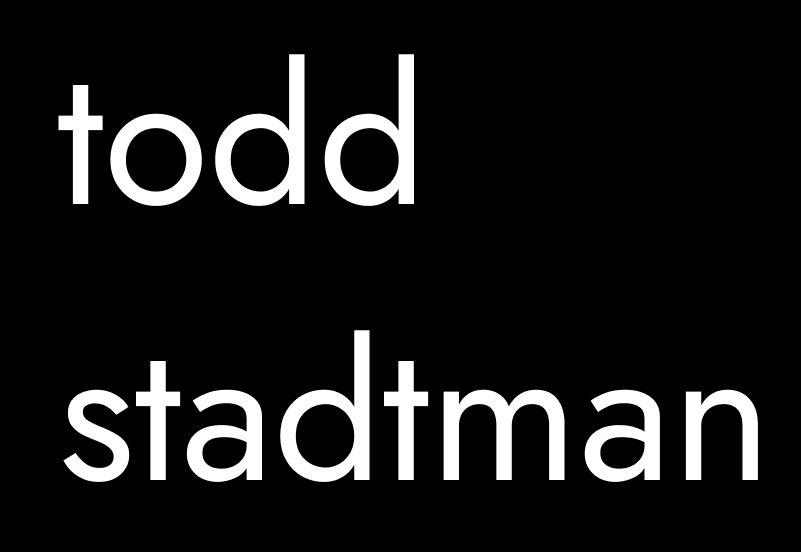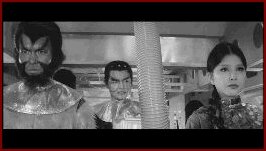|
Ogon Batto
Ogon Batto (Golden Bat) is in many ways typical of the type of films Sonny Chiba appeared in before he became an international action star with the Street Fighter movies. Under a long term contract with Toei Studios, he racked up an impressive slate of low budget B movies during the sixties, a good number of kiddie-themed science fiction films among them. His turn as Iron Sharp in Uchu Kaisokusen (aka Invasion of the Neptune Men), as well as his starring roles in the Toei TV series Nanairo Kamen and Ala-no Shishai, also made him a veteran of the costumed hero Tokusatsu genre of which Ogon Batto is squarely a part, though in Ogon he was, for once, spared having to be the guy in the silly super hero costume (an honor that went to actor Hirohisa Nakata). This might have provided a nice break for Chiba - as well as an opportunity to enjoy a bit of shadenfreude at Nakata's expense - but it also results in a rare instance in which the charismatic and energetic Chiba is rendered relatively low-key by all that is going on around him. For, while Ogon Batto may have little in terms of art that distinguishes it from other such films in Chiba's early filmography, it does have a certain energy to its presentation that clearly sets it apart. Ogon Batto begins with Akira, a young amateur astronomer, making the shocking discovery that the planet Icarus has gone off course and is heading rapidly toward Earth. No sooner has Akira made his case to the disbelieving staff at a nearby observatory than he is whisked away by a cadre of Men In Black and taken to the headquarters, hidden in the Japanese Alps, of The Pearl Research Institute, a secret, UN-backed organization dedicated to studying strange space phenomena. Here he meets Capt. Yamatone (Chiba), who promptly asks Akira to join the institute - because, despite being a kid, he obviously knows a lot about science and stuff. Akira accepts, and is immediately introduced to Doctor Pearl and his granddaughter Emily, a twelve-year-old child who, in classic Japanese sci fi movie fashion, obviously holds a position of some responsibility at the institute. Doctor Pearl shows Akira the Super Destruction Beam Cannon, a ray gun with the power of "1000 Hydrogen bombs" designed to blast Icarus out of the sky before it can hit Earth. Unfortunately, Pearl tells him, the cannon is not yet operational, because a special mineral is needed to create its lens. No sooner has Pearl said this than the team receives word that an expedition searching for that very mineral has run into trouble and is not responding to contact. At this, the entire staff - man, woman and child - pours into the institute's flying Super Car and takes off over the ocean. Soon the location of the expedition is spotted - it's the lost continent of Atlantis! No sooner has the team landed on Atlantis and found the entire expedition team dead than a giant tower - looking like a mile high drill bit with a squid's head on it - rises up from the ocean and starts shooting cartoon laser beams at them.
This tower is the base of Nazo, the self-proclaimed Ruler of the Universe, who wants to destroy humanity because "No one else should exist except for me, Nazo!" With Nazo's foot soldiers hot on their heels, the team retreats into a temple, where they find an ornate sarcophagus. On the sarcophagus is an inscription stating that, 10,000 years from the date of that inscription, a crisis would erupt that would necessitate the aid of the Golden Bat, the occupant of the sarcophagus, who could conveniently be resuscitated by just adding water. As the foot soldiers close in, Emily follows those instructions and revives the Golden Bat, a hulking figure in Gold lycra and skull mask, who proceeds to beat the enemy into retreat with his Baton of Justice. With Nazo and his minions gone for the moment, Golden Bat informs Emily that, because it was she who revived him, only she can summon his aid - and with that makes his magic bat mascot affix itself to her uniform in the form of a bat-shaped broach. He also informs the team that, now that he has been revived, Atlantis will once again sink below the ocean. The team makes for the Super Car and manages to take off in the nick of time as Atlantis crashes back beneath the waves. And so, ladies and gentlemen, goes the first fifteen minutes of Ogon Batto. And things don't really slow down much from there. The film may be a pure, hastily made, low budget construction (just how many commercial Japanese films were still being made in black and white in 1966?), but there is one thing of which you can be guaranteed: By the time you reach the end of its seventy-minute running time, you will have seen an awful lot of stuff happen in a very short period of time.
While the Golden Bat is a lesser known Japanese super hero compared to the likes of Ultraman or Kamen Rider, he is no less a venerable one. His origin dates back to the early thirties, and is attributed, depending on who you ask, to either pulp magazines or to kami-shibai, a practice of live storytelling with printed illustration cards that was popular with children in that era. Whichever is the case, he would later make the transition to manga, where he would, at one time, be rendered by the capable hands of the master himself, Osamu Tezuka (Tetsuwan Atom, aka Astroboy, and Jungle Emperor Leo, aka Kimba). A year after his feature incarnation in Ogon Batto, he would go on to make his debut in a popular animated television series, making this movie just one stop in his journey toward total Japanese media domination. A live action television series would follow in the early seventies. It is clear that the Bat's manga incarnation is the inspiration for Ogon Batto, and its one of the film's most admirable qualities that it tries to stay true to the look of that source, even if with mixed results. The Nazo that appears in the comics, for instance, is a distinctly weird creation, sort of an amorphous black shape with bat ears and four-laser firing eyes who has a hovering flying saucer in place of a lower body. There is definitely an attempt to duplicate that look on the part of Ogon's art department, but with the resources they had to work with, Nazo just ends up looking like a man in a big floppy flannel sack - and because the effect of him hovering above the ground with no lower body was hopelessly beyond their means, the actor simply keeps his bottom half hidden within a stationary saucer-shaped control console. Nazo's tower, on the other hand, really looks like a manga creation given real world dimensions, and it's one of the movie's visual treats. The model is put to its best use during the film's climax, in which the tower suddenly erupts from the bowels of the Earth directly below Tokyo and rises up to loom threateningly over the city's skyline (a scene closely parodied in the 2004 live-action film version of the 70s anime Cutey Honey). In fact, all of the film's models - from the tower to the shark-shaped flying submarine that Nazo's toadies use to travel between it and their various villainous assignations - are imaginative and fun, and none the less so for all the visible wires used to put them in motion.
As for the Golden Bat himself, he seems here to be the kind of super hero whose super powers rely mostly on you being repeatedly told by the other characters in the movie just how super powerful he is. His preferred method of combat is running around and clubbing people one-by-one with his baton while stopping to strike highly stylized dramatic poses, which doesn't give the appearance of being that much more effective than the ray guns the members of the Pearl Institute are equipped with. Furthermore, he always announces himself with a laugh that is obviously meant to be ghostly and fear-inspiring, but which sounds more like the kind of chattering, forced laughter that just makes people uncomfortable. Whenever he does this, you kind of expect Sonny and company to start uneasily and halfheartedly laughing along while slipping each other nervous sideways glances. And when he flies it just looks ridiculous. All of this, of course, somehow combines to make the guy actually kind of loveable, though I don't think that was the intention. And speaking of striking highly stylized dramatic poses, that practice is not limited to just the Golden Bat here. In fact, the whole cast gets in on that action, and it's most memorable when a whole group of them, reacting en masse to some shocking revelation or bit of off-screen business, do it all at the same time. It comes across kind of like a cross between silent movie acting and Vogueing. I realize that this film was produced in an era when camp was a dominant aesthetic in popular culture. But, as campy as all that comes across, I don't think that the intention of the makers of Ogon Batto was to poke fun at their subject matter, but rather to use that prevailing aesthetic as carte blanche for them to be absolutely as corny as they wanted to be. The result is a film that's the cinematic distillation of the spirit embodied in the phrase "Gee whiz!"
Back in the plot of Ogon Batto, Nazo, rallying after the whole Atlantis debacle, sends three of his evil emissaries to infiltrate the Pearl Institute headquarters. This trio includes Jackal, a wolf-man, Piranha, a woman in a scaly fish outfit, and Keloid, a Grandpa Munster look-alike with oatmeal on his face. After a series of frantic ray gun battles and the Golden Bat showing up to run around and club people with his baton, the villains succeed in making off with the Super Destruction Beam Cannon, only to find that it is missing the crucial lens (which, by the way, has now been successfully fabricated by Doctor Pearl and company, thanks to a gem comprised of the necessary mineral being in the Golden Bat's hand when he was found in his sarcophagus at the beginning of the movie). Taking on the appearance of Naomi, another member of the institute, Piranha kidnaps Emily, and soon both Emily and Doctor Pearl are being held hostage by Nazo, with the lens stated as the price of their safe release. This leads to the final showdown between the Golden Bat and Nazo, held high above the streets of Tokyo (and involving, among other things, a dog fight with that cool shark-shaped flying submarine), as the rogue planet Icarus hurtles perilously ever closer to our seemingly doomed Earth. And just where is Sonny Chiba in all this, you may ask? Well, he does have his heroic moments, but the top-billed star seems mostly content to blend into the background and let all of the insanity just happen around him. Which is a very sensible attitude to take with Ogon Batto. It's an easy film to mock, but if you take the time to step back and appreciate just how furiously it's working to entertain you, you'll find that it's equally easy to love. Just don't expect it to be a showcase for the Street Fighter himself.
- Todd Stadtman 12/12/07
|
||
|
All text content � Copyright 2007 Todd Stadtman. All rights reserved. |













